Downloads
Introduction
Good morning and thank you for the opportunity to speak today. This morning, as requested, I will be giving you a bit of an “inside perspective” into the Tax White Paper from a Treasury perspective. I will be discussing the importance of tax reform, the opportunities, the benefits and the challenges. I will also delve into Treasury’s role, where we are up to in the Tax White Paper process and what we have heard from the community.
Why tax reform is important
Tax reform is not an end in itself. Rather, reform to the tax system should be seen in a much bigger picture of Australia’s economic and social progress.
As the Prime Minister and Treasurer have said, we have extraordinary economic opportunities in Australia. To make the most of them, we need to make our economy more adaptable, more productive and more innovative. Incentives need to be right, including the incentives generated from the tax system.
I want to expand more on what our changing world means for our tax system and focus on the big picture. I will mention three areas of change: the first being the impact of technological innovation and globalisation; the second, the ageing of the population; and last, productivity and the living standards challenge for Australia.
Technological innovation and globalisation
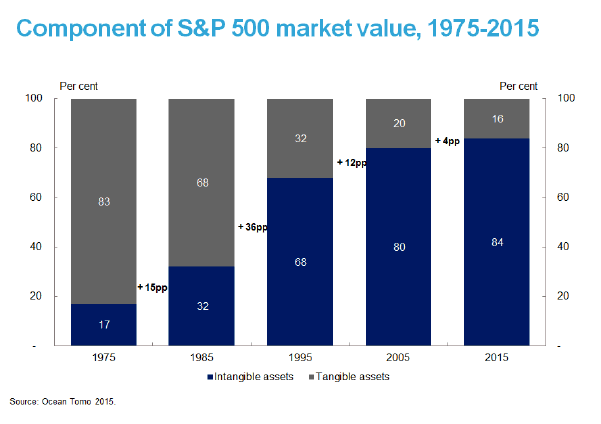
The first big area of change is technological innovation and globalisation. Technology is profoundly shaping our economies and our everyday lives. This has been of huge benefit to humanity. But it does also strike challenges, including for tax systems that were designed in a very different age. An example is the rapidly growing role of things that are intangible – that can be hard to value or to determine their source – in the global economy.
In the past 40 years, intangible assets have grown from less than a fifth of the market value of the S&P 500 to more than four-fifths. Furthermore, companies now have greater ability as to where they locate their operations. This poses a particular challenge to company tax going forward, and reinforces the need to ensure our tax rules, which are already robust, remain up to the task.
It is also reasonable to think that with globalisation, labour mobility may increase in future, particularly for highly skilled workers, which would raise the economic costs of our progressive income tax system.
So we need a tax system that is both robust in the face of technological change and which appropriately supports innovation going forward.
Ageing of the population
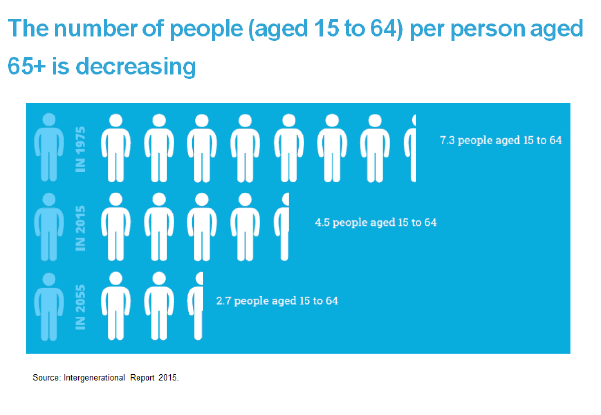
A second area of change is our ageing population and workforce participation.
There will be a substantial decline in the relative size of the population of traditional working age – those who usually pay the most income tax – and this will put pressure on our tax system. IGR projections are for only 2.7 15 to 64 year olds for every person aged 65+ by 2055 (currently 4.5).
Over the past 40 years, we have seen an increase in the participation rate among older groups between 1978-79 and 2013-14, the participation of people aged 55 to 64 increased from 45.6 per cent to 63.8 per cent and while we have also seen increases in female participation rates, we lag behind other comparable countries Australia’s female participation rate is around 4 percentage points lower than that in New Zealand and Canada.
We would benefit from a tax and transfer system that provided greater encouragement for work.
Productivity and promoting growth in living standards
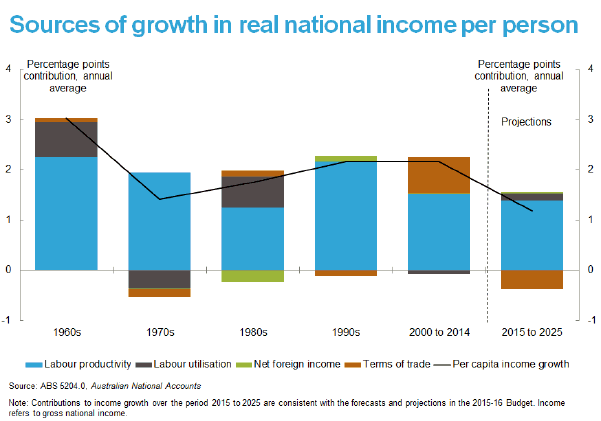
Finally, we have a productivity challenge and opportunity. Australia has been blessed, experiencing almost a quarter of a century of uninterrupted economic growth and strong growth in our standard of living. Previous growth has been assisted by the rise in female participation, earlier waves of economic reform and the mining boom.
Since the turn of the century, our productivity performance has waned, both by our own standards and relative to our international peers. Current rates of average labour productivity growth remain well below the rates – around 2½ per cent – experienced in the late 1990s and early 2000s.
This is all the more important because we are facing some significant headwinds. We have already seen substantial falls in our terms of trade, which mean that for a given level of output we are receiving less income. Australia’s terms of trade peaked in 2011 and the subsequent decline has driven falls in national income. Real per capita national income has been falling since 2012-13 and is not projected to return to that year’s level until 2017-18.
Tax reform can improve our economic productivity (and participation) and lead to a significant boost to living standards. Many argue it would lead to a bigger boost than any other single area of government policy.
But before I go into that, it is worth spelling out clearly why tax has negative economic effects. As a general rule, taxes impose costs on the economy by distorting the decisions of households, firms and investors. That is, they distort key economic choices – eg, about to engage in paid work or not; how much to save and in what form; how much to invest in skill acquisition. All real-world taxes impact some of these choices. A more efficient tax system is one that reduces these distortions from an economy-wide perspective.
So, given that framework, how does our current system stack up? The short answer is not as well as it could.
This is clear from the following chart.
Australia’s taxes
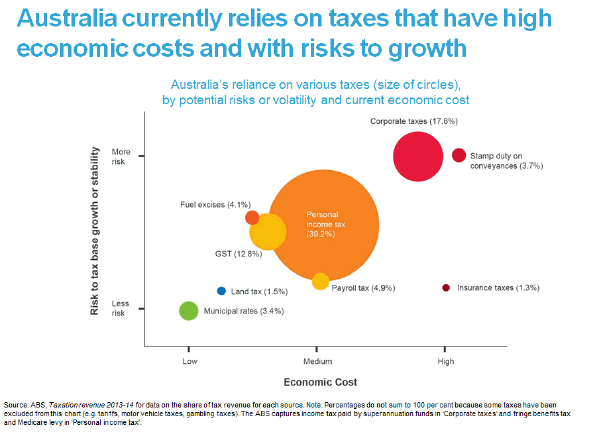
This chart shows the economic cost of the more significant taxes in Australia. They could be roughly grouped into three categories in terms of economic efficiency.
The taxes with the highest marginal excess burdens are stamp duties on conveyances, company income tax and insurance taxes.
Stamp duties are one of the most inefficient taxes levied in Australia. Unlike broad-based taxes on consumption or payrolls, stamp duties are applied to the total transaction value rather than the ‘value added’ component. Stamp duties, when expressed as a percentage of the economic value associated with a transaction, are actually levied at very high rates.
The economic cost of a tax increases with the square of the rate. So at high tax rates, stamp duties on conveyance have significant economic costs. On top of this, by discouraging the exchange and reallocation of residential and business property, stamp duties discourage the allocation of property to those who value it most. This distortion adds to the economic cost of stamp duties.
Other modelling also suggests that insurance taxes have high costs for a similar reason; it has very high effective rates.
The second is the high reliance on company tax and our relatively high company tax rate (both statutory and effective rate).
Australia’s company tax rate is high by global standards, particularly given that many other countries have substantially reduced their corporate tax rates:
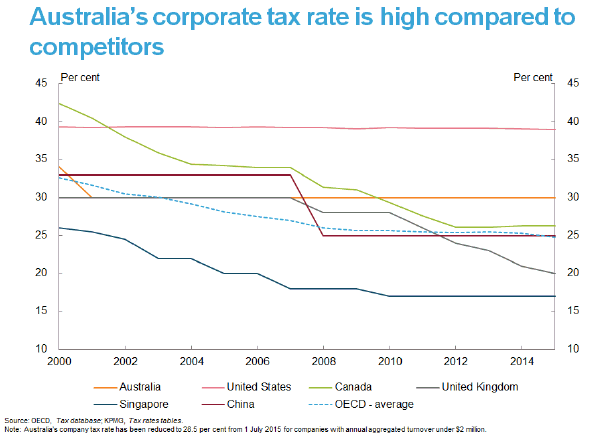
With this higher rate of company tax, Australia has a much greater reliance on company tax than comparable jurisdictions:
Why does our high company tax rate matter? It matters because it affects the level of investment into Australia, and in turn our stock of capital and p
roductivity of workers. And as Paul Krugman says, productivity isn’t everything, but in the long run it is almost everything.
Now it is true that Australia has enjoyed high rates of investment in the past and we continue to attract foreign investment. But the world is an increasingly competitive place – as other countries improve their policy settings, we can expect they will attract more foreign investment. While we have natural advantages in the resource sector, we need foreign investment to develop other parts of our economy.
While it is generally accepted that lower company tax will increase foreign investment, it is less accepted where the benefits will go. In the near term, you would expect an increase in foreign investment (versus what it would otherwise be) as more investments become profitable under the new tax regime. Over time, this investment is used to build structures and other types of capital.
In the longer run, the higher capital stock would also lead to greater productivity and hence higher real wages for Australian workers. This contributes to an improvement in GDP and welfare.
Treasury has estimated that a reduction in the company income tax rate to 25 per cent, with a corresponding shift to more efficient taxes on labour or consumption, could generate long term gains to GDP of 1 per cent over 20 years. This is associated with an increase in real wages of around 1 per cent. Treasury also estimates that the second-round economic gains, although slow to accrue, would fund around 40 per cent of the direct revenue cost of a 25 per cent company tax rate.
However, one of the immediate impacts of a lower company tax rate is still to lower the tax being paid by foreign investors on the return to their existing investments. The short term consequences certainly need to be taken into account in mapping out a way forward. It is instructive in this regard to look at the UK experience which is to set forth a path of cuts in the company tax rate while managing the cost by phasing them in over time.
The third tax I want to discuss is personal income tax. High marginal tax rates, including through the interaction with the social security system, can dampen participation, investment in human and physical capital and entrepreneurship. Other countries rely much less than we do on progressive taxes, and more on flat rate consumption or social security taxes.
Australia’s top statutory income tax rate is 45 cents in the dollar. And on top of that you need to add the 2 per cent Medicare Levy and the temporary deficit reduction levy. By way of contrast, New Zealand’s top income tax rate is just 33 per cent. For example, a single person in New Zealand earning NZ$40,000 a year would pay 18.95 cents in tax on their next dollar of income and pay NZ$6,600 in tax for the year.1 In Australia, someone earning A$40,000 would pay 36 cents in tax on their next dollar of income, yet pay annual tax of only A$4,947.2
Our personal income tax system is also highly progressive. For example, in 2012-13, the top ten per cent of individual tax payers paid almost 45 per cent of total personal income tax collected by the Government. In contrast, the bottom 50 per cent of taxpayers paid around 12 per cent of personal income tax.
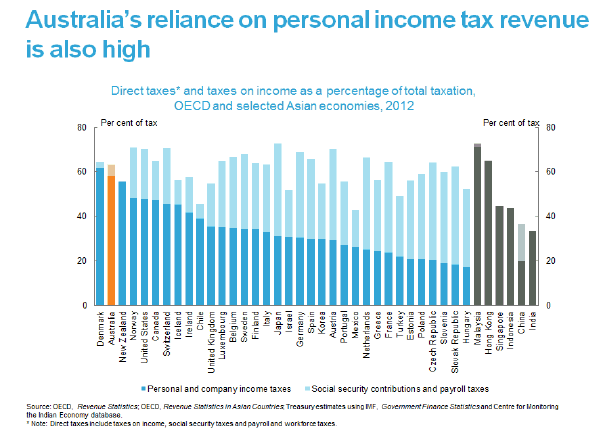
So, to the extent we can reform our tax system to improve incentives for working, investing and entrepreneurship, this will have benefits for growth and living standards.
States and tax reform
States play an important role in tax reform and it seems fitting given I am in Victoria to mention your own work on tax reform. An example is the major changes to the Fire Services Levy, which is used to fund emergency fire services. The levy was previously collected through a loading on insurance premiums but is now collected through council rates notices by reference to the value of the relevant property (this is similar to a broad-based land tax). This change has broadened the revenue base – all property owners must pay the levy, not just those with insurance. The reform has moved revenue collection from a tax which significantly distorts economic decisions (charges on insurance are regarded as discouraging people and businesses from taking out insurance on their property). The State now raises this revenue from a broad-based land tax – a revenue base which has a very limited effect on the economy and living standards.
This reform is a useful example of how the tax system can be made more economically efficient - Victoria has reduced its reliance on an inefficient tax and increased its reliance on a more efficient one.
Other states are also making progress on tax reforms. This includes the ACT’s phased cuts to stamp duty and South Australia’s phased abolition of stamp duty on non-residential real property transfers, over a three year period.
However, there clearly remain big opportunities to do more.
The Challenges of Tax Reform
There are big opportunities from tax reform, but there are, of course, significant challenges. Some of these are analytical, such as the effects of different tax choices on participation and productivity. While economic analysis assists, judgement remains important for policy development.
Beyond the technical, there are a lot of difficult and controversial choices. There will more often than not be a tension between efficiency, equity and simplicity when developing tax policy. For example, sometimes to address an integrity issue very complex rules may be needed, and choices have to be made as to whether the integrity benefits are worth the complexity cost.
There are features in our tax system that are contentious. We have seen, for example, an active debate on issues like superannuation, negative gearing and dividend imputation. It is important these issues are considered from a broad perspective, and consultation is very important to achieve that. It is also important that the trade-off between changes in one part of the system with potential changes in other parts is considered. A tax preference in one area may be desirable, but is it more desirable than a reduction in tax elsewhere? Thus, in undertaking tax reform, reforms must also be assessed from a whole tax system perspective as there will always be interlinkages causing both positive and negative flow-on effects.
Where is the Tax White Paper process up to and what is Treasury’s role?
Now I’d like to spend some time on the Tax White Paper process and where it is up to including Treasury’s role, the feedback we’ve received from the community and next steps.
As you all know, the Government released its Tax Discussion Paper in March. There has been an extensive submissions process and stakeholder meetings, and the next stage in the process is the release of an Options Paper (known in government circles as a Green paper).
In assisting the Government undertake this work, Treasury has sought to leverage off its existing strengths, but also work in some new ways.
One area Treasury has focused on recently is the development of its CGE or economy-wide macroeconomic modelling, particularly as it relates to tax. This modelling enables the effect of policy change on participation, productivity and economic activity and living standards to be modelled. This is particularly important in considering tax reform, where one of the key benefits of reform can be higher economic activity and living standards. The publication of the economic costs of taxation in the Discussion Paper has been very well received, including the associated working paper which provides extensive discussion about what drives the results.
Treasury has long recognised that having good analysis is a necessary but not sufficient condition for successful reform. To be successful, reform must win broad community support. While ultimately it is a matter for government to drive the strategy, Treasury can assist.
Since the launch of the discussion paper we’ve helped to facilitate the national conversation on tax reform. One of the biggest challenges in enabling an informed debate is to translate the legal and economic concepts around taxation, to something tangible and relevant to the Australian community. While we certainly do not expect people to have conversations about marginal excess burdens around their dinner table, we hope to make tax reform a little more accessible!
We have opened up more avenues for people to participate in the conversation on tax reform through our interactive website bettertax.gov.au. With the aim to help to educate and inform the public, the website has hosted tax themed quizzes, quick comments, animations and infographics – like tax topic specific in five slides - as well as more traditional website content.
Who did we hear from and what did we hear?
Overall the Tax White Paper Task Force received over 870 formal submissions, with:
- Around 470 from individuals.
- Around 400 from organisations.
There have been a large number of well-considered and articulate submissions from across the breadth of Australian enterprise. All submissions, with the exception of those that have been marked as confidential, are available on the bettertax website.
Who did we hear from?
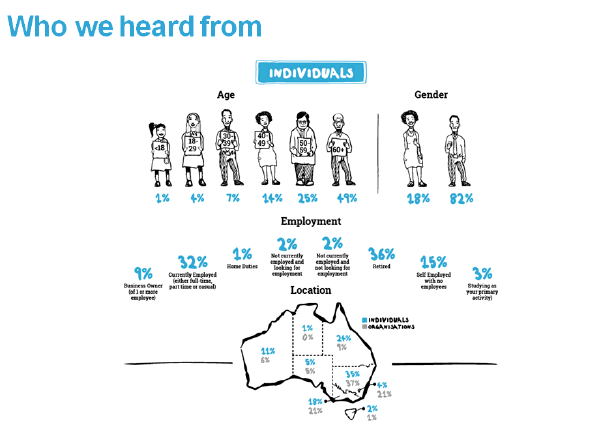
As you can see, from the snapshot on screen, we received submissions from a broad section of the community.
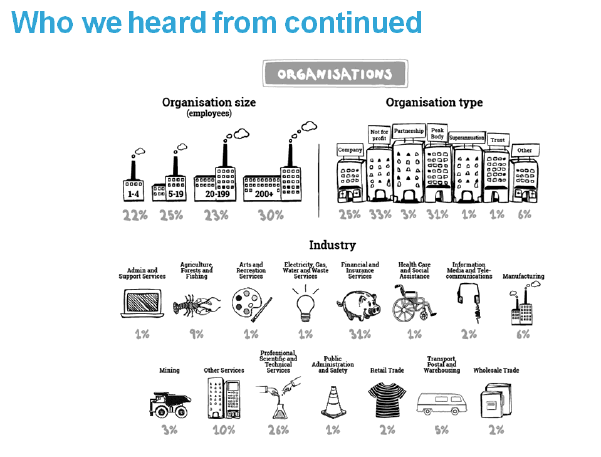
We received submissions from organisations of various sizes, most of whom were not-for-profit organisations, peak bodies and companies including professional services firms, unions, social welfare groups and religious organisations.
The main industries that made formal submissions were the financial and insurance services, professional, scientific and technical services.
What we heard
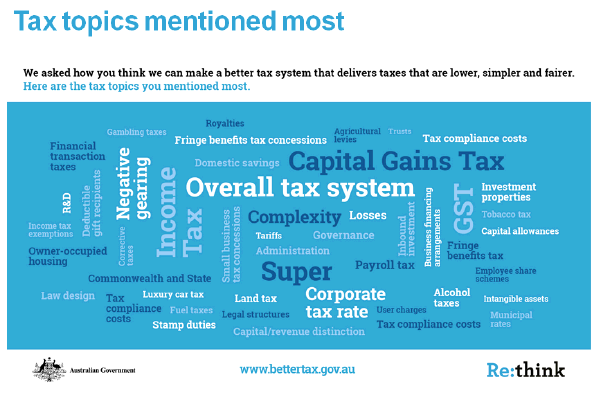
Looking at this word cloud, the top five tax topics mentioned the most from submissions were superannuation, GST, income tax, the overall tax system and capital gains tax. While these were the tax topics mentioned the most, we did received submissions on most aspects of Australia’s tax system.
Broadly, there was widespread support for reform and dissatisfaction with the level of complexity in the tax system.
Themes from submissions included:
Imputation: There is consensus that dividend imputation should be retained.
Superannuation: There is support for reducing existing superannuation concessions, but no clear agreement on how this should occur.
GST: There is support for broadening the GST base and/or increasing the rate, conditional on compensation for people with low incomes.
Personal income tax: The majority of views supported lower personal income tax rates.
Capital gains tax: There is support for less concessional treatment of capital gains, although current arrangements are strongly supported by sections of the business community.
Corporate income tax: The majority of views expressed support a reduction in the company tax rate, many suggest 25 per cent would be appropriate.
Stamp duties: Overwhelming majority of views expressed support reduction/abolition of stamp duties.
Payroll tax: Majority support abolishing or harmonising payroll tax.
Savings: Many argue that different classes of savings should be taxed in a similar way.
Consultation
Treasury has held around 120 stakeholder meetings on tax reform since the launch of the discussion paper. This has supported the extensive engagement the Government has also undertaken.
We have engaged with operators of large and small businesses, unions, social welfare groups, industry associations, other government officials, think tanks, private individuals and academics.
We’ve heard a range of opinions and are taking them on board as part of the tax white paper process.
The Board of Tax has also held its own round tables and targeted consultations with businesses and organisations across Australia. We have found this very helpful in Treasury.
What is also pleasing is the extent to which the private sector has helped drive public engagement, including the AFR/Australian Reform Conference – co-hosted by the Tax Institute, the recent AFR Tax reform conference, and a host of other events. Most recently, we have seen the Prime Minister’s reform summit with Ministers, and leading business and community representatives which also engaged widely and constructively on the big challenges and opportunities facing Australia, including tax.
What’s next?
The next major step in the process is the release by the Government of the Options (Green) Paper. Treasury is assisting the Government work through the various options and choices which could be included.
Conclusion
To conclude, I hope what I have discussed here today has given you an “inside perspective” into the Tax White Paper process as well as what some of the major challenges, opportunities and benefits of tax reform.
1 Includes Accident Compensation Corporation earner’s levy.
2 Includes Medicare levy and low-income tax offset.